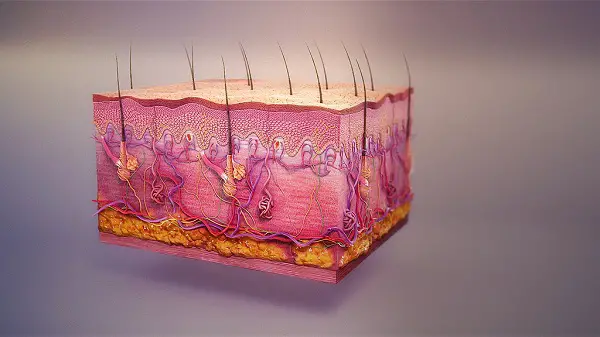The Integumentary System
The integumentary system protects against physical injury, infection, excessive heat or cold, and drying out. It consists of the skin, hair, and nails.
Skin
The skin consists of two layers: the epidermis and the dermis. The outermost layer of cells, the epidermis, is a stratified squamous epithelium with many layers of flat cells. Rapid cell division occurs at the epidermis, replenishing the skin cells that get constantly abraded from the body surface.
As the layers of skin cells are pushed to the apical surface, they fill with the protein keratin and release a waterproofing glycolipid. This protects the body from dehydration and prevents penetration by microbes. The inner layer of the skin, the dermis, is made of fairly dense connective tissue with many elastic fibers and strong collagen fibers, the thinning of the latter leading to wrinkles.
The dermis also contains the hair follicles, oil and sweat glands, muscles, nerves, and blood vessels. The presence of blood vessels functions in temperature regulation. Sensory receptors are present in the skin and provide environmental information to the brain.
Beneath the skin lies the hypodermis which is a layer of adipose tissue. Another function of the skin is the synthesis of vitamin D, which is used for absorbing calcium. The synthesis of vitamin D is sped up by UV rays which is why we are advised to expose to the sun’s rays during early mornings.

Hair
In mammals, hair is an important component of the integumentary system. It is a flexible shaft of flattened, keratin-filled dead cells, produced from a hair follicle. Associated with hair follicles are the oil glands which help lubricate the hair, condition the surrounding skin, and inhibit the growth of bacteria.
Hair follicles also serve an important sensory function. You can sense how sensitive it is just by lightly touching your hair on the head.
Hairs also insulate the bodies of animals but in humans, this is limited to the head. Land animals raise their fur when cold to trap air and increase the insulating power of their fur.
Nails
The nails are the final components of the integumentary system. These protective coverings are also composed of keratin. Fingernails are used in manipulation with our limbs and in other mammals, the digits may end in claws or hooves.
Next topic: Digestive System
Return to the main article: Animal Form and Functions (Overview)
Download Article in PDF Format.
Test Yourself!
1. Practice Questions [PDF Download]
2. Answer Key [PDF Download]
Copyright Notice
All materials contained on this site are protected by the Republic of the Philippines copyright law and may not be reproduced, distributed, transmitted, displayed, published, or broadcast without the prior written permission of filipiknow.net or in the case of third party materials, the owner of that content. You may not alter or remove any trademark, copyright, or other notice from copies of the content. Be warned that we have already reported and helped terminate several websites and YouTube channels for blatantly stealing our content. If you wish to use filipiknow.net content for commercial purposes, such as for content syndication, etc., please contact us at legal(at)filipiknow(dot)net
